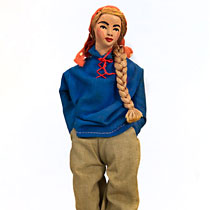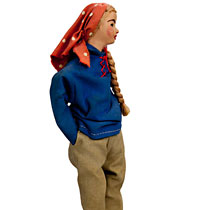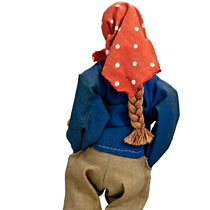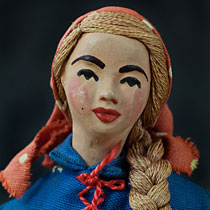Description of Figure/Doll
This Israeli doll is dressed as if to ready to work in a kibbutz. She has a red head scarf and blue woven shirt. Her hands are in the pockets of her casual pants. Her body is created with wire that is covered with drinking straws. Her torso is stuffed material, and her head is composition. Tag says: “WIZO Home Industries Made in Israel” to learn more about life in a kibbutz culture, read the story.
Link to higher resolution images at ClipPix
Israel
Location: Middle East
Capital: Jeruselum
Main language: Hebrew
Currency: New Israeli shekel
Figure/Doll
Construction: wire & straws
Height in Centimeters: 18
Height in Inches: 7
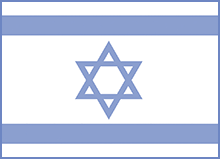
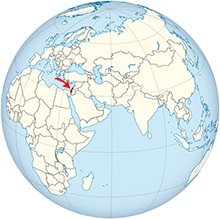
Living in an Israeli Kibbutz
Reading Level: 5.40
Esther was nine years old when her rabbi father and mother moved from New York City to Israel. Israel is a small country, far away from New York. It is desert land that is full of sand. Esther missed her old neighborhood in New York. She had enjoyed walking to the butcher shop with her mother and to the grocery store where shelves were stacked with kosher food. She loved to buy bagels, borscht (beet soup), lox (smoked salmon), cream cheese, egg matzahs and gefilte fish. On Saturdays most of the Jewish people went to the synagogue.
Then her parents decided to move to Israel to begin a new life on a farm. The kibbutz community farm they lived in was once a desert. Then the Jewish people dug deep wells so they could grow fruits and vegetables. Esther and her family lived in a small house, but they ate in a large dining room with the other 50 settlers. Each family was assigned certain duties and everyone pitched in to make the farm successful. Esther’s family worked very hard on the farm from Sunday to Friday. On Saturday they all walked to the synagogue to pray.
But all was not perfect. As Esther was working in the field, she often heard the sound of gunfire. She worried that the shooting would come close to her home and family. It seemed like the Jews of Israel were always fighting with the Arabs of Palestine. Her father explained that the Palestinians used to live on this land, until a war in 1967.
One day, as Esther was working in the field, she saw some movement between the houses. She saw a young boy dressed in Arab clothes by one of the buildings. The boy was younger than Esther. He looked tired and frightened. Esther walked slowly over to the boy and held up her finger, telling him to be quiet. Esther spoke very little Arabic, so she tried English. The boy did not understand. Next, Esther spoke in Yiddish, but still no answer. Finally she asked the boy his name in Hebrew. The boy said his name was Amil.
Amil told Esther he was hunting wild birds, but he went too far and he was lost. Esther took Amil to the leader of the kibbutz. After sunset Esther, Amil, and the leader drove to the tiny village and delivered Amil to his parents. Esther and her new friend hugged each other, promising that they would visit again some day. As Esther drove back to the kibbutz, she hoped that one day all Jews and Arabs would live in peace and friendship.

